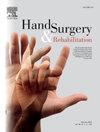Lateral elbow epicondylitis recognized as an occupational disease: Evaluation of return to work after surgery in 49 patients with an average follow-up of 45.6 months
IF 1
4区 医学
Q4 ORTHOPEDICS
引用次数: 0
Abstract
Objectives
The primary objective of this study was to evaluate the return to previous work activities following surgery for lateral epicondylitis recognized as an occupational disease. The secondary objectives were to assess the relationship between preoperative and postoperative periods of work stoppage, and to determine the influence of different factors on the ability to return to previous activity.
Material and method
The demographic, occupational and medical data of 49 patients were analyzed retrospectively with a mean follow-up period of 45.6 months.
Results
At last follow-up, 26.5% of patients had returned to their previous activity. Preoperative and postoperative time off work were correlated (R = 0.331; p = 0.0323). Preoperative time off work of less than 12 months was significantly associated with a better ability to return to previous work (p = 0.017). Postoperative time off work and return to previous activity were significantly related (OR = 0.65; p = 0.012). The length of preoperative time off work appears to be an important factor to take into account in the context of occupational disease. The duration of postoperative time off work was consistent with French literature, but highlights significant international variability.
Conclusion
A quarter of patients who undergo surgery in a professional context return to their previous activity. Close collaboration among various stakeholders appears essential throughout the patient’s care pathway.
Level of evidence
IV. Retrospective study.
公认为职业病的外侧肘上髁炎:49例患者术后恢复工作的评估,平均随访45.6个月。
目的:本研究的主要目的是评估被认为是职业病的外上髁炎手术后恢复工作活动的情况。次要目的是评估术前和术后停工时间之间的关系,并确定不同因素对恢复先前活动能力的影响。材料与方法:回顾性分析49例患者的人口学、职业及医学资料,平均随访时间45.6个月。结果:在最后一次随访中,26.5%的患者恢复了以前的活动。术前与术后休假时间相关(R = 0.331;p = 0.0323)。术前休假时间少于12个月与较好的恢复工作能力显著相关(p = 0.017)。术后休息时间与恢复先前活动显著相关(OR = 0.65;p = 0.012)。术前休假时间的长短似乎是一个重要的因素,考虑到职业病的情况下。术后休息时间的长短与法国文献一致,但突出了显著的国际差异。结论:四分之一在专业环境下接受手术的患者恢复到以前的活动。在病人的整个护理过程中,各利益相关者之间的密切合作显得至关重要。证据水平:IV.回顾性研究。
本文章由计算机程序翻译,如有差异,请以英文原文为准。
求助全文
约1分钟内获得全文
求助全文
来源期刊

Hand Surgery & Rehabilitation
Medicine-Surgery
CiteScore
1.70
自引率
27.30%
发文量
0
审稿时长
49 days
期刊介绍:
As the official publication of the French, Belgian and Swiss Societies for Surgery of the Hand, as well as of the French Society of Rehabilitation of the Hand & Upper Limb, ''Hand Surgery and Rehabilitation'' - formerly named "Chirurgie de la Main" - publishes original articles, literature reviews, technical notes, and clinical cases. It is indexed in the main international databases (including Medline). Initially a platform for French-speaking hand surgeons, the journal will now publish its articles in English to disseminate its author''s scientific findings more widely. The journal also includes a biannual supplement in French, the monograph of the French Society for Surgery of the Hand, where comprehensive reviews in the fields of hand, peripheral nerve and upper limb surgery are presented.
Organe officiel de la Société française de chirurgie de la main, de la Société française de Rééducation de la main (SFRM-GEMMSOR), de la Société suisse de chirurgie de la main et du Belgian Hand Group, indexée dans les grandes bases de données internationales (Medline, Embase, Pascal, Scopus), Hand Surgery and Rehabilitation - anciennement titrée Chirurgie de la main - publie des articles originaux, des revues de la littérature, des notes techniques, des cas clinique. Initialement plateforme d''expression francophone de la spécialité, la revue s''oriente désormais vers l''anglais pour devenir une référence scientifique et de formation de la spécialité en France et en Europe. Avec 6 publications en anglais par an, la revue comprend également un supplément biannuel, la monographie du GEM, où sont présentées en français, des mises au point complètes dans les domaines de la chirurgie de la main, des nerfs périphériques et du membre supérieur.
 求助内容:
求助内容: 应助结果提醒方式:
应助结果提醒方式:


